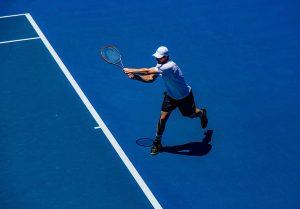We may earn money or products from the companies mentioned in this post.
Introduction

Tennis, often dubbed the “sport of kings,” is a game that requires finesse, strategy, and skill One crucial aspect of tennis is the volley – a technique that can make or break a player’s performance on the court In this article, we will explore the definition and purpose of a tennis volley, as well as delve into the importance of mastering this technique in order to gain an edge over opponents
Definition of a Tennis Volley
At its core, a tennis volley refers to hitting the ball before it bounces on one’s side of the court Unlike groundstrokes where players hit the ball after it has bounced, volleys require quick reflexes and precise timing This technique is often executed when an opponent hits a shorter or weaker shot, allowing players to take control of the point by striking the ball out of mid-air
The Purpose of a Volley in Tennis
The primary purpose of executing a volley in tennis is to maintain control over rallies and put pressure on opponents By intercepting the ball before it touches the ground, players have less time to react and strategize their next move Volleys are particularly effective at close range when players are positioned near or inside the service line They allow for aggressive shots that can catch opponents off guard and force errors
Importance of Mastering the Volley Technique
Mastering the volley technique in tennis can significantly enhance one’s overall game and provide numerous advantages during matches
Advantages of Using Volleys in a Tennis Match
-
Varying Play Style:
Incorporating volleys into your gameplay repertoire allows you to diversify your play style With strong volleys at your disposal, you can mix up shots and keep opponents guessing, making it harder for them to anticipate your next move -
Shortening Points:
Efficient volleys enable players to end points quickly by placing the ball precisely where their opponent cannot reach it This reduces the risk of long and exhausting rallies, conserving energy for future games -
Net Dominance:
By mastering volleys, players gain an advantage at the net This dominance allows them to cut off angles, control the pace of the game, and effectively counter opponents’ shots -
A Defensive Weapon:
Volleys are not solely offensive maneuvers; they can also act as a defensive weapon Executing well-timed volleys in response to powerful groundstrokes or passing shots can neutralize opponents’ attacks and turn defense into offense
In conclusion, the tennis volley is a crucial technique that carries immense importance in enhancing a player’s performance on the court By understanding its definition, purpose, and advantages, aspiring tennis enthusiasts can work towards mastering this skill and elevating their overall gameplay
Types of Tennis Volleys

Tennis volleys are an essential part of a player’s repertoire, allowing them to quickly and efficiently return shots at the net There are two main types of tennis volleys: the forehand volley and the backhand volley Each type requires specific grips, racket positioning, footwork, and body positioning to execute successfully
Forehand Volley
The forehand volley is a crucial shot in tennis, allowing players to quickly and aggressively attack the ball at the net To execute a forehand volley effectively, it is important to have the proper grip and racket positioning
-
Eastern Forehand Grip:
The Eastern forehand grip is commonly used for volleys as it provides stability and control It involves placing the base knuckle of your index finger on the third bevel of your racket handle -
Continental Grip:
The Continental grip can also be used for forehand volleys, especially when looking for more power in your shots This grip involves placing your hand on the handle with your palm facing towards you
Once you have established the correct grip, executing a forehand volley requires precise footwork and body positioning You need to position yourself close to the net with your feet shoulder-width apart, knees slightly bent, and weight evenly distributed between both legs
The contact point for a forehand volley should be in front of your body with your racket positioned slightly above your wrist As you make contact with the ball, focus on keeping your wrist firm but flexible to generate controlled power Follow through by extending your arm towards your target while maintaining balance
Backhand Volley
The backhand volley is another critical shot in tennis, allowing players to effectively return shots on the opposite side of their body Similar to the forehand volley, the proper grip and racket positioning are essential for executing a successful backhand volley
-
Eastern Backhand Grip:
The Eastern backhand grip is commonly used for backhand volleys as it allows for better control and maneuverability This grip involves placing the base knuckle of your index finger on the second bevel of your racket handle -
Continental Grip:
The Continental grip can also be utilized for backhand volleys if you prefer more power in your shots This grip involves placing your hand on the handle with your palm facing towards you
When executing a backhand volley, similar footwork and body positioning principles apply Position yourself close to the net with feet shoulder-width apart, knees slightly bent, and weight evenly distributed between both legs
The contact point for a backhand volley should be slightly in front of your body with your racket positioned above your wrist Focus on keeping your wrist firm but flexible as you make contact with the ball, generating controlled power Follow through by extending your arm towards your target while maintaining balance
Volley Strategies and Tactics

Approach Shots: Setting up the Volley
An effective approach shot in tennis can be a game-changer, providing numerous advantages on the court Firstly, it forces weak returns from your opponents, putting them under pressure right from the start This sets you up for success by giving you more control over the point
Additionally, a well-executed approach shot creates opportunities to close out points at the net By moving forward strategically, you can take advantage of any weak shots or short balls from your opponent This allows you to seize control of the point and finish it with confidence
Serve-and-Volley Technique
Serve-and-volley tactics are an excellent way to add variety and surprise to your game while keeping your opponent on their toes One major benefit is that it puts immense pressure on returners as they have less time to react and prepare their shots
Another advantage of implementing serve-and-volley tactics is that it shortens points, leading to increased efficiency on the court By approaching the net quickly after a well-placed serve, you reduce the amount of time your opponent has to respond effectively
Executing serve-and-volley effectively requires a few key elements Firstly, choosing the right serve type (flat, slice, kick) is crucial as it sets up different opportunities for attacking at the net Secondly, mastering split step timing and footwork will help you move swiftly towards the net with precision Lastly, anticipating returns allows you to position yourself optimally for successful volleys
Common Mistakes & Tips for Improvement

Forehand Volley Mistakes & Solutions
When it comes to the forehand volley, there are a couple of common mistakes that players often make One of them is hitting with too much wrist movement, which can lead to inconsistent shots To improve this, you should practice keeping your wrist firm during contact with the ball By doing so, you’ll have better control and accuracy in your volleys
Another mistake to watch out for is poor footwork and body positioning This can result in awkward and off-balance shots To address this issue, focus on split-step timing and maintaining an active stance A well-timed split-step allows you to quickly react to incoming shots, while an active stance helps you stay balanced and ready for any volley
Backhand Volley Mistakes & Solutions
The backhand volley also has its fair share of common mistakes that players need to be aware of One such mistake is over-swinging or not following through properly on the shot This can result in wild and unpredictable volleys To overcome this issue, practice controlled, compact swings with proper extension By doing so, you’ll have more consistency and control over your backhand volleys
Another mistake that many players make is not preparing the racket early enough for a backhand volley This leads to rushed and late shots that lack power and precision To improve in this area, develop a quicker reaction by anticipating returns earlier By being proactive in your preparation, you’ll be able to execute clean and well-timed backhand volleys
General Tips for Improving Volley Technique
In addition to addressing specific mistakes in forehand and backhand volleys, there are some general tips that can help improve your overall volley technique
- Consistent practice of volleys in various match situations is crucial By regularly incorporating volleys into your training sessions, you’ll develop muscle memory and improve your reflexes, making it easier to execute volleys during actual matches
- Watching professional players for technique and strategy inspiration can be highly beneficial Observing how the best players in the world handle their volleys can give you valuable insights and ideas to incorporate into your own game
By addressing specific mistakes and implementing these general tips, you’ll be well on your way to improving your volley technique and becoming a more confident and effective player at the net
Useful Links

Volley. Meaning in tennis. Definition. Wiki. Terms
Improving Forehand and Backhand Volley
7 Tips for Hitting a Clean Volley Every Time
Tennis Tip: How to volley with power!
Tennis Volleys: Definition, Steps & Tips (with Photos)
Tennis 101: The 6 Basic Strokes Explained Step-by-Step
7 Volley Types You Must Know To Master Your Net Game
How To Volley In Tennis? [5 Volleying Techniques In 2023]
The Swinging Volley is a Cheat Code
Gym Test: Tennis Flashcards
The drop shot volley is the only volley to use in singles
Tennis Strokes | Tennis Shots | Forehand | Backhand | Serve
Volley | Prince of Tennis Wiki – Fandom
What Is A Volley In Tennis?
Fix Your Tennis Volley
Tennis Volley Drills | Volley Video Tips
Rivard: The lost art of serve and volley
What Is A Half Volley In Tennis
What is The Tennis Volley and How Is It Executed?






